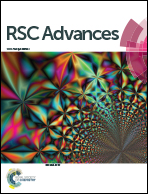Color-tunable smectite : Eu(L)2 (L = Phen, Bpy) hybrid materials from red to blue: internal bond rotation and reduction by hydrazine
Abstract
Eu(Phen)23+ complexes are successfully intercalated into the interlayer space of smectite minerals with three different layer charges, whereas the Bpy molecules are not intercalated even at the higher solution temperature of 200 °C, probably due to the internal bond rotation of the aryl–aryl single bond, resulting in the variable van der Waals thickness of the guest molecule (Bpy). In the red-emitting Smectite : Eu(Phen)23+ hybrid materials, the orientation model of the Eu(Phen)23+ complex in which the plane of the aromatic ring of the Phen molecule is parallel to the silicate layer (possibly slightly tilted) is proposed based on the variation of the d(001) basal spacings before and after Eu(Phen)23+ intercalation. Furthermore, the novel blue emission in smectite : Eu(Phen)2 hybrid materials is obtained using hydrazine solution, for the first time. In combination with the PL and XPS results of smectite : Eu(Phen)2 hybrid materials, it is evident that the Eu3+ of the Eu(Phen)23+ complex stabilized into the interlayer space of the smectite mineral is reduced to Eu2+ by hydrazine. The solution chemistry using hydrazine to gain the lower valence state of metal ions allows us to explore new inorganic–organic hybrid materials that are particularly susceptible to high temperature.


 Please wait while we load your content...
Please wait while we load your content...